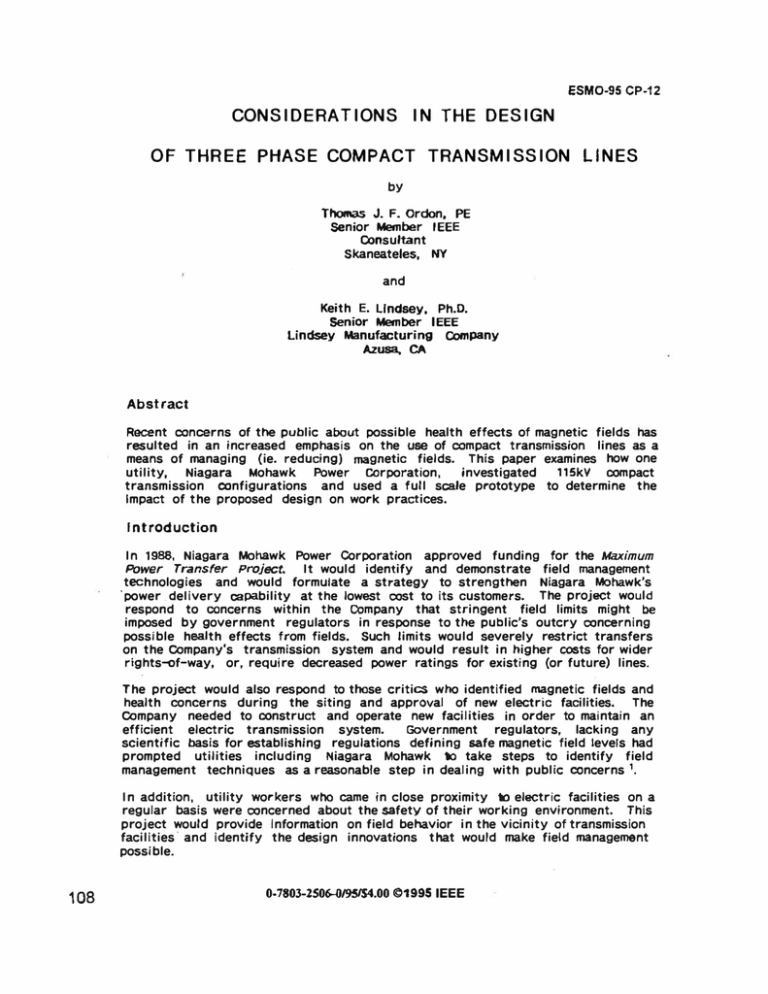Design of Compact Transmission Lines
advertisement

ESM0-95 CP-12 CONSIDERATIONS IN THE DESIGN OF THREE PHASE COMPACT TRANSMISSION LINES by Thomas J. F. Ordon, PE Senior Member IEEE Consultant Skaneateles, NY and Keith E. Lindsey., Ph.D. Senior Member IEEE Lindsey Manufacturing Azusa, CA Company Abstract Recent concerns of the public about possible health effects of magnetic fields has resulted in an increased emphasis on the use of compact transmission lines as a means of managing (ie. reducing) magnetic fields. This paper examines how one utility, Niagara Mohawk Power Corporation, investigated 115kV compact transmission configurations and used a full scale prototype to determine the Impact of the proposed design on work practices. Introduction In 1988, Niagara Mohawk Power Corporation approved funding for the Maximum It would identify and demonstrate field management technologies and would formulate a strategy to strengthen Niagara Mohawk's "power. delivery capability at the lowest cost to its customers. The project would respond to concerns within the Company that stringent field limits might be imposed by government regulators in response to the public's outcry concerning possible hea.lth effects from fields. Such limits would severely restrict transfers on the company's transmission system and would result in higher costs for wider rights-of-way, or, require decreased power ratings for existing (or future) lines. Power Transfer Project. The project would also respond to those critics who identified magnetic fields and health concerns during the siting and appr·oval of new electric facilities. The company needed to construct and operate new facilities in order to maintain an efficient electric transmission system. Government regulators, lacking any scientific basis for establishing regulations defining safe magnetic field levels had prompted utilities including Niagara Mohawk to take steps to identify field management techniques as a reasonable step in dealing with public concerns 1• In addition, utility workers who came in close proximity to electric facilities on a regular basis were concerned about the safety of their working environment. This project would provide Information on field behavior in the vicinity of transmission facilities· and identify the design innovations that would make field management possible. 108 0-7803-2S0�/951$4.00 ©1995 IEEE Background Niagara Mohawk's study investigated designs which could be used for the construction of new 115kV overhead electric transmission systems with lower ground level fields than the Company's conventional horizontal design. It was proPOSed to develop a structure which could be constructed with existing materials and experience and which could be put into service in a relatively short time at the lowest additional cost. ia " .• " e ·-:s" � II -� ,I 0 r L l • • 11 ·-e-· Design Compared The study 2 recommended Figure with Niagara Mohawk's Standard the following l L PROPOSED INVERTED DB.TA TANGENT STRUC'TURE STANDARD H-RlAME TANGENT STRUCTURE Proposed 1e ·-er Design design: a compact inverted delta phase arrangement with a phase to phase conductor spacing of 6 feet 4 inches (Figure 1) magnetic fields produced by the new design would be 25" of the magnetic fields produced by the standard horizontal design at both normal design load and at maximum allowable design load, radio noise levels generated the standard design would be 5 to 10 dB higher than those of audible noise levels would be negligible in-span spacers would dropping or galloping be used to prevent flashovers due to ice 109 A more detailed discussion of selection for compact lines can Compact Lines". 3 Design loadings, mechanical be found in "Practical reactions and hardware Aspects of Hardware for Review It is a Niagara Mohawk requirement to have the Company's Hot Stick Committee review .any new �tructural system or structure if that system or structure would be recommended as a s.ystem approved standard, The Committee. eventually consists of supervisory personnel from the Operating, Safety, and Training Departments. Members of the Committee would also examine the work procedures necessary when performing maintenance on the structure and how existing work .practices were affected. The Committee determined very early in the project that their review could not be accomplished by examining drawir:igs or specifications. In order to determine if the configuration could be installed, maintained and operated in accordance with Niagara Mohawk work practices, it was agreed that a prototype of the structure should be erected. This would permit the Committee to examine the design and test various work procedures in full scale, life size circumstances. Committee members concentrated specifically on confirming that required working clearanc�s were maintained and that individual conductor support insulators could be replaces . using hot-stick techniques. Structure Prototype Figure 2 Erected for Testing at the Test Site Following completion of the detailed design of the tangent structure, materials were ordered and a prototype of the proposed design (Figure 2) was erected at a test site. A section of line consisting of three spans simulated actual conditions. The test line was not energized. The Hot Stick Committee verified the adequacy of the working clearances between the poles and the crossarm and the conductors, and determined how linemen could access the structure to work on the conductor hardware assembly. The Committee concluded that personnel should be able to work from th� crossarm and that the use of support platforms would facilitate 111 working from the poles. In order to permit these procedures and maintain requir-ed working distances between energized components and a worker on the structure, it was necessary to increase the spacing between the wood poles and the spacing between the crossarm and the conductor support assembly. The -eh.anges r:ecommen.ded were: increasing pole separation increasing spacing from 16 feet to 19 feet 6 inches between the crossarm and the conductors from 5 f..eet to 11 f.eet 2 inches The prototype at the site was modified to incorporate these changes Figure 3 Modified Prototype Figure Removing 112 the Inner 4 Insulators in the "U" String (Figure 3). The Hot Stick Committee investigated how insulator assemblies could be replaced using hot-stick techniques. It was demonstrated and confirmed by actually performing the procedure that the outer string in the "U", the inner string of the "U" (Figure 4) and, finally, the insulators in the "V" (Figure 5) could be successfully removed and re-installed using hot sticks. Removing Figure 5 the Insulators in the "V" String The Committee also examined the in-span spacers (Figure 6). Three (3) individual polymer interphase spacers were used at a span location. A tool which can be operated with a hot stick and which will reduce the forces on any one interphase A prototype spacer and facilitate its removal and installation is being developed. of the tool was successfully demonstrated. Figure 6 In-Span I nterphase Spacers 113 The Hot Stick Committee employed one· Company line truck with a bucket and the Company hot-stick trailer to perform their investigation at the test site. Following the work of the Hot Stick Committee and a review of the results, the design of the structure was finalized and drawings and a bill of material were prepared. The structure has been used as part of a new 115kV project north of Syracuse, Niagara Mohawk is now working to NY. 4 Its performance is being monitored. develop angle and strain structures for the low EMF 115kV family of structures. Conclusions The following conclusions resulted from this project: a full scale prototype of a propased structure is an ideal way for a utility to identify and investigate proposed work practices reduced work-space and the complex reactions to forces acting on a "U" string requires careful attention to work procedures standard conductor hardware does lend itself for use in compact conductor configurations, for example, special yoke plates and suspension clamps are required for use in a "UM string The development of the low EMF structure by Niagara Mohawk is an evolutionary process. The work that I have described demonstrates how Niagara Mohawk addressed the task of determining how the use of a new and non-standard conductor support system should be evaluated to determine compliance with the Company's work rules. References 114 1. Ordon, Thomas J. F., "A Utility Perspective on Factors Driving Line compaction'', 13th IEEE/PES Transmission and Distribution Conference and Exposition, Chicago, Illinois, April 10-15, 1994 2. Stewart, James R. and Douglas, Dale A., "Development of a Low EMF Structure for the Schodack 115kV Tap Line Project for Niagara Mohawk Power Corporation'', (Report), Power Technologies, Inc., June 25, 1992 3. Lindsey, Dr. Keith E., "Practical Aspects of Hardware for COmpact Lines", 13th IEEE/PES Transmission and Distribution Conference and Expasition, Chicago, Illinois, April 10-15, 1994 4. Ordon, Thomas J. F., "Maximum Power Transfer, (Project 08-9429), 115kV Inverted Delta Structure", (Repcrt), Niagara Mohawk Power Corporation, February 16, 1994




